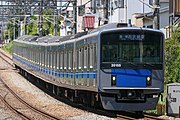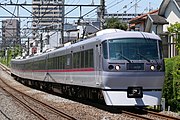Seibu Shinjuku Line
This article needs additional citations for verification. (September 2014) |
| Seibu Shinjuku Line | ||||||||||||||||||||||||||||||||||||||||||||||||||||||||||||||||||||||||||||||||||||||||||||||||||||||||||||||||||||||||||||||||||||||||||||||||||||||||||||||||||||||||||||||||||||||||||||||||||||||||||||||||||||||||||||||||||||||||||||||||||||||||||||||||||||||||||||||||||||||||||||||||||||||||||||||||||||||||||||||||||||||||||||||||||||||||||||||||||||||||||
|---|---|---|---|---|---|---|---|---|---|---|---|---|---|---|---|---|---|---|---|---|---|---|---|---|---|---|---|---|---|---|---|---|---|---|---|---|---|---|---|---|---|---|---|---|---|---|---|---|---|---|---|---|---|---|---|---|---|---|---|---|---|---|---|---|---|---|---|---|---|---|---|---|---|---|---|---|---|---|---|---|---|---|---|---|---|---|---|---|---|---|---|---|---|---|---|---|---|---|---|---|---|---|---|---|---|---|---|---|---|---|---|---|---|---|---|---|---|---|---|---|---|---|---|---|---|---|---|---|---|---|---|---|---|---|---|---|---|---|---|---|---|---|---|---|---|---|---|---|---|---|---|---|---|---|---|---|---|---|---|---|---|---|---|---|---|---|---|---|---|---|---|---|---|---|---|---|---|---|---|---|---|---|---|---|---|---|---|---|---|---|---|---|---|---|---|---|---|---|---|---|---|---|---|---|---|---|---|---|---|---|---|---|---|---|---|---|---|---|---|---|---|---|---|---|---|---|---|---|---|---|---|---|---|---|---|---|---|---|---|---|---|---|---|---|---|---|---|---|---|---|---|---|---|---|---|---|---|---|---|---|---|---|---|---|---|---|---|---|---|---|---|---|---|---|---|---|---|---|---|---|---|---|---|---|---|---|---|---|---|---|---|---|---|---|---|---|---|---|---|---|---|---|---|---|---|---|---|---|---|---|---|---|---|---|---|---|---|---|---|---|---|---|---|---|---|---|---|---|---|---|---|---|---|---|---|---|---|---|---|---|---|---|---|---|---|---|---|---|---|---|---|---|---|---|---|---|---|---|---|---|---|---|
Seibu Shinjuku | ||||||||||||||||||||||||||||||||||||||||||||||||||||||||||||||||||||||||||||||||||||||||||||||||||||||||||||||||||||||||||||||||||||||||||||||||||||||||||||||||||||||||||||||||||||||||||||||||||||||||||||||||||||||||||||||||||||||||||||||||||||||||||||||||||||||||||||||||||||||||||||||||||||||||||||||||||||||||||||||||||||||||||||||||||||||||||||||||||||||||||
| Stations | 29 | |||||||||||||||||||||||||||||||||||||||||||||||||||||||||||||||||||||||||||||||||||||||||||||||||||||||||||||||||||||||||||||||||||||||||||||||||||||||||||||||||||||||||||||||||||||||||||||||||||||||||||||||||||||||||||||||||||||||||||||||||||||||||||||||||||||||||||||||||||||||||||||||||||||||||||||||||||||||||||||||||||||||||||||||||||||||||||||||||||||||||
| Service | ||||||||||||||||||||||||||||||||||||||||||||||||||||||||||||||||||||||||||||||||||||||||||||||||||||||||||||||||||||||||||||||||||||||||||||||||||||||||||||||||||||||||||||||||||||||||||||||||||||||||||||||||||||||||||||||||||||||||||||||||||||||||||||||||||||||||||||||||||||||||||||||||||||||||||||||||||||||||||||||||||||||||||||||||||||||||||||||||||||||||||
| Type | Commuter rail | |||||||||||||||||||||||||||||||||||||||||||||||||||||||||||||||||||||||||||||||||||||||||||||||||||||||||||||||||||||||||||||||||||||||||||||||||||||||||||||||||||||||||||||||||||||||||||||||||||||||||||||||||||||||||||||||||||||||||||||||||||||||||||||||||||||||||||||||||||||||||||||||||||||||||||||||||||||||||||||||||||||||||||||||||||||||||||||||||||||||||
| Depot(s) | Minami-Iriso | |||||||||||||||||||||||||||||||||||||||||||||||||||||||||||||||||||||||||||||||||||||||||||||||||||||||||||||||||||||||||||||||||||||||||||||||||||||||||||||||||||||||||||||||||||||||||||||||||||||||||||||||||||||||||||||||||||||||||||||||||||||||||||||||||||||||||||||||||||||||||||||||||||||||||||||||||||||||||||||||||||||||||||||||||||||||||||||||||||||||||
| Daily ridership | 945,302 (FY2010)[1] | |||||||||||||||||||||||||||||||||||||||||||||||||||||||||||||||||||||||||||||||||||||||||||||||||||||||||||||||||||||||||||||||||||||||||||||||||||||||||||||||||||||||||||||||||||||||||||||||||||||||||||||||||||||||||||||||||||||||||||||||||||||||||||||||||||||||||||||||||||||||||||||||||||||||||||||||||||||||||||||||||||||||||||||||||||||||||||||||||||||||||
| History | ||||||||||||||||||||||||||||||||||||||||||||||||||||||||||||||||||||||||||||||||||||||||||||||||||||||||||||||||||||||||||||||||||||||||||||||||||||||||||||||||||||||||||||||||||||||||||||||||||||||||||||||||||||||||||||||||||||||||||||||||||||||||||||||||||||||||||||||||||||||||||||||||||||||||||||||||||||||||||||||||||||||||||||||||||||||||||||||||||||||||||
| Opened | 1894 | |||||||||||||||||||||||||||||||||||||||||||||||||||||||||||||||||||||||||||||||||||||||||||||||||||||||||||||||||||||||||||||||||||||||||||||||||||||||||||||||||||||||||||||||||||||||||||||||||||||||||||||||||||||||||||||||||||||||||||||||||||||||||||||||||||||||||||||||||||||||||||||||||||||||||||||||||||||||||||||||||||||||||||||||||||||||||||||||||||||||||
| Technical | ||||||||||||||||||||||||||||||||||||||||||||||||||||||||||||||||||||||||||||||||||||||||||||||||||||||||||||||||||||||||||||||||||||||||||||||||||||||||||||||||||||||||||||||||||||||||||||||||||||||||||||||||||||||||||||||||||||||||||||||||||||||||||||||||||||||||||||||||||||||||||||||||||||||||||||||||||||||||||||||||||||||||||||||||||||||||||||||||||||||||||
| Line length | 47.5 km (29.5 mi) | |||||||||||||||||||||||||||||||||||||||||||||||||||||||||||||||||||||||||||||||||||||||||||||||||||||||||||||||||||||||||||||||||||||||||||||||||||||||||||||||||||||||||||||||||||||||||||||||||||||||||||||||||||||||||||||||||||||||||||||||||||||||||||||||||||||||||||||||||||||||||||||||||||||||||||||||||||||||||||||||||||||||||||||||||||||||||||||||||||||||||
| Track gauge | 1,067 mm (3 ft 6 in) | |||||||||||||||||||||||||||||||||||||||||||||||||||||||||||||||||||||||||||||||||||||||||||||||||||||||||||||||||||||||||||||||||||||||||||||||||||||||||||||||||||||||||||||||||||||||||||||||||||||||||||||||||||||||||||||||||||||||||||||||||||||||||||||||||||||||||||||||||||||||||||||||||||||||||||||||||||||||||||||||||||||||||||||||||||||||||||||||||||||||||
| Electrification | 1,500 V DC, overhead catenary | |||||||||||||||||||||||||||||||||||||||||||||||||||||||||||||||||||||||||||||||||||||||||||||||||||||||||||||||||||||||||||||||||||||||||||||||||||||||||||||||||||||||||||||||||||||||||||||||||||||||||||||||||||||||||||||||||||||||||||||||||||||||||||||||||||||||||||||||||||||||||||||||||||||||||||||||||||||||||||||||||||||||||||||||||||||||||||||||||||||||||
| Operating speed | 105 km/h (65 mph) | |||||||||||||||||||||||||||||||||||||||||||||||||||||||||||||||||||||||||||||||||||||||||||||||||||||||||||||||||||||||||||||||||||||||||||||||||||||||||||||||||||||||||||||||||||||||||||||||||||||||||||||||||||||||||||||||||||||||||||||||||||||||||||||||||||||||||||||||||||||||||||||||||||||||||||||||||||||||||||||||||||||||||||||||||||||||||||||||||||||||||
| ||||||||||||||||||||||||||||||||||||||||||||||||||||||||||||||||||||||||||||||||||||||||||||||||||||||||||||||||||||||||||||||||||||||||||||||||||||||||||||||||||||||||||||||||||||||||||||||||||||||||||||||||||||||||||||||||||||||||||||||||||||||||||||||||||||||||||||||||||||||||||||||||||||||||||||||||||||||||||||||||||||||||||||||||||||||||||||||||||||||||||
The Seibu Shinjuku Line (西武新宿線, Seibu-Shinjuku-sen) is a Japanese railway line owned by the private railway operator
The Shinjuku Line is one of two main lines of the Seibu Railway system along with the Ikebukuro Line. The two main lines cross at Tokorozawa Station in Tokorozawa, Saitama. The line serves the western suburbs of Tokyo, connecting them to Shinjuku and other areas of downtown Tokyo.
Description

The line is mostly double-track, except for 1.1 km (1200 yards) of single track between Wakita Junction and Hon-Kawagoe Station. While the section from Seibu-Shinjuku to Takadanobaba is elevated, the line runs at ground level through a suburban area until Saginomiya.
Trains
Seven types of train service are operated on the line: Local, Semi Express, Express, Commuter Express, Rapid Express, Haijima Liner, and Koedo limited express, as shown below. Limited Express trains use Seibu 10000 series EMUs, and a supplementary limited express ticket is required. In addition, operation of the all-seat reserved train "Haijima Liner" using the Seibu 40000 series EMU started from March of 2018. The "Haijima Liner" operates from Seibu-Shinjuku to Haijima on weekends and in both directions on weekdays.[2]
There are regular through operations to the
Through service onto the Seibu Kokubunji Line has been suspended since 19 March 2019 because of the reconstruction of Higashi-Murayama Station into an elevated station.[3]
Stations
- O: stop
- |: pass
- ▽:For trains heading to Seibu-Shinjuku: Alighting passengers only / For trains heading to Haijima: Boarding passengers only
- ▲:For trains heading to Seibu-Shinjuku: Alighting passengers only / For trains heading to Haijima: Both alighting and boarding passengers
- L: Local (各停, Kakutei) stop at all stations, not shown
- SE: Semi Express (準急, Junkyū)
- E: Express (急行, Kyūkō)
- CE: Commuter Express (通勤急行, Tsūkin Kyūkō)
- RE: Rapid Express (快速急行, Kaisoku Kyūkō)
- HL: Haijima Liner (拝島ライナー, Haijima Rainā)
- LE: Limited Express Koedo-go (特急「小江戸号」, Tokkyū Koedo-gō)
| No. | Station | Japanese | Distance (km) |
SE | E | CE | RE | HL | LE | Transfers | Location | |
|---|---|---|---|---|---|---|---|---|---|---|---|---|
| SS01 | Seibu-Shinjuku | 西武新宿 | 0.0 | O | O | O | O | O | O | JY Yamanote Line
JB Chuo-Sobu Line
JA Saikyo Line
M Tokyo Metro Marunouchi Line (M-08) S Toei Shinjuku Line (S-01) E Toei Oedo Line Shinjuku (E-27), Shinjuku-nishiguchi (E-01)
|
Shinjuku
|
Tokyo |
| SS02 | Takadanobaba | 高田馬場 | 2.0 | O | O | O | O | ▽ | O | JY Yamanote Line T Tokyo Metro Tozai Line (T-03) | ||
| SS03 | Shimo-Ochiai | 下落合 | 3.2 | | | | | ↑ | ↓ | ↓ | | | |||
| SS04 | Nakai | 中井 | 3.9 | | | | | ↑ | ↓ | ↓ | | | E Toei Oedo Line
| ||
| SS05 | Araiyakushi-mae | 新井薬師前 | 5.2 | | | | | ↑ | ↓ | ↓ | | | Nakano | ||
| SS06 | Numabukuro | 沼袋 | 6.1 | | | | | ↑ | ↓ | ↓ | | | |||
| SS07 | Nogata | 野方 | 7.1 | | | | | ↑ | ↓ | ↓ | | | |||
| SS08 | Toritsu-Kasei | 都立家政 | 8.0 | | | | | ↑ | ↓ | ↓ | | | |||
| SS09 | Saginomiya | 鷺ノ宮 | 8.5 | O | O | O | ↓ | ↓ | | | |||
| SS10 | Shimo-Igusa | 下井草 | 9.8 | | | | | ↑ | ↓ | ↓ | | | Suginami
| ||
| SS11 | Iogi | 井荻 | 10.7 | | | | | ↑ | ↓ | ↓ | | | |||
| SS12 | Kami-Igusa | 上井草 | 11.7 | | | | | ↑ | ↓ | ↓ | | | |||
| SS13 | Kami-Shakujii | 上石神井 | 12.8 | O | O | O | ↓ | ↓ | | | Nerima
| ||
| SS14 | Musashi-Seki | 武蔵関 | 14.1 | O | | | ↑ | ↓ | ↓ | | | |||
| SS15 | Higashi-Fushimi | 東伏見 | 15.3 | O | | | ↑ | ↓ | ↓ | | | Nishitōkyō
| ||
| SS16 | Seibu-Yagisawa | 西武柳沢 | 16.3 | O | | | ↑ | ↓ | ↓ | | | |||
| SS17 | Tanashi | 田無 | 17.6 | O | O | O | O | ↓ | | | |||
| SS18 | Hana-Koganei | 花小金井 | 19.9 | O | O | ↑ | ↓ | ↓ | | | Kodaira | ||
| SS19 | Kodaira | 小平 | 22.6 | O | O | ↑ | ↓ | ▲ | | | |||
| SS20 | Kumegawa | 久米川 | 24.6 | O | O | ↑ | ↓ | | | Higashimurayama | |||
| SS21 | Higashi-Murayama | 東村山 | 26.0 | O | O | O | O | O | ||||
| SS22 | Tokorozawa | 所沢 | 28.9 | O | O | O | O | O | Tokorozawa | Saitama | ||
| SS23 | Kōkū-kōen | 航空公園 | 30.5 | O | O | ↑ | ↓ | | | ||||
| SS24 | Shin-Tokorozawa | 新所沢 | 31.7 | O | O | O | O | | | ||||
| SS25 | Iriso | 入曽 | 35.6 | O | O | ↑ | O | | | Sayama
| |||
| SS26 | Sayamashi | 狭山市 | 38.6 | O | O | O | O | O | ||||
| SS27 | Shin-Sayama | 新狭山 | 41.3 | O | O | ↑ | O | | | ||||
| SS28 | Minami-Ōtsuka | 南大塚 | 43.9 | O | O | ↑ | O | | | Seibu Ahina Line (Freight, closed) | Kawagoe | ||
| SS29 | Hon-Kawagoe | 本川越 | 47.5 | O | O | O | O | O | TJ Tobu Tojo Line (Kawagoeshi Station )
| |||
Rolling stock
In service
Commuter trains
-
2000 series
-
New 2000 series
-
6000 series
-
20000 series
-
30000 series
-
40000 series
Limited express trains
-
10000 series
History
The oldest section of the Shinjuku Line is between Higashi-Murayama Station and Hon-Kawagoe Station. This section was built by the Kawagoe Railway (川越鉄道, Kawagoe Tetsudō) to serve as a freight feeder for the Kōbu Railway (甲武鉄道, Kōbu Tetsudō) between Shinjuku and Tachikawa (now known as the Chūō Main Line). The initial Kawagoe Railway route opened between Kokubunji and Kumegawa in 1894; this portion is now known as the Seibu Kokubunji Line. Its northward extension to Kawagoe, the first part of what is now the Seibu Shinjuku Line, opened in 1895. Following several mergers and name changes between 1920 and 1922, the Kawagoe Railway became part of the Seibu Railway.[citation needed]
In 1927, Seibu Railway built its new dual track, electrified at 1,500 V DC, Murayama Line between Takadanobaba Station on the Yamanote Line in Tokyo and Higashi-Murayama Station to compete with Musashino Railway (武蔵野鉄道, Musashino Tetsudō) (present-day Seibu Ikebukuro Line) and the Japanese National Railways Chūō Main Line, the route being in the middle of the two.[citation needed] The rest of the line was electrified at the same time.[citation needed]
The Higashi-Murayama to Tokorozawa section was double-tracked between 1950 and 1958, with the Tokorozawa to Irimagawa section double-tracked between 1967 and 1975. The rest of the line (except for the section between the Wakita Junction and Hon-Kawagoe Station) was double-tracked between 1980 and 1991.[citation needed]

In 1952, a dual-track extension from Takadanobaba to Seibu-Shinjuku Station was completed. At this time the line was renamed the Shinjuku Line, integrating the Murayama Line and the northern section of the Kawagoe Line. The new Seibu-Shinjuku terminal was built as a temporary station, as Seibu planned to extend the line to the second floor of what is now known as Lumine Est on the east side of Shinjuku Station. This plan was later scrapped due to insufficient space to handle trains longer than six cars. Seibu-Shinjuku Station was expanded to include a high-rise hotel in 1977.[5]
From the start of the revised timetable on 30 June 2012, the Haijima rapid (拝島快速, Haijima kaisoku) and Rapid Express (快速急行, Kaisoku Kyūkō) services were abolished.[6]
Station numbering was introduced on all Seibu Railway lines during fiscal 2012, with Seibu Shinjuku Line stations numbered prefixed with the letters "SS"(SeibuShinjuku line).[7]
From the timetable revision on 14 March 2020, the limited-stop Rapid Express (快速急行, Kaisoku Kyūkō) was reinstated for weekend and holiday services.[8]
Express tunnel
In the 1980s, Seibu drew up a plan to build an underground line for express trains between Seibu-Shinjuku and Kami-Shakujii, including a new underground station between Seibu-Shinjuku and the Metro Promenade. This plan was indefinitely postponed in 1995 due to costs and a decline in passenger ridership versus previous projections.[5] Seibu was also a bidder to acquire the former JR freight terminal site in 1989, where they planned to build a new underground terminal; Takashimaya won the bid and constructed the Takashimaya Times Square complex on the site.[citation needed] In 2019, the Tokyo Metropolitan Government officially cancelled the plan.[9]
Future expansion
Through operations with the Tokyo Metro Tozai Line
During the 1960s, Seibu unsuccessfully negotiated with the
Grade separation projects
Initial work has started on grade separating the line from Nogata to Iogi Stations[12] and from Iogi to Seibu-Yagisawa Stations.[13] Proposals are being done to for grade separating the line from Tanashi to Hanakoganei Stations[14] and from Takadanobaba to Nakai Stations.[15]
See also
References
This article incorporates material from the corresponding article in the Japanese Wikipedia
- ^ Seibu ridership in 2010 Train Media (sourced from Seibu) Retrieved May 28, 2012.
- ^ "「拝島ライナー」上り列車の運行詳細が決定" (PDF). Seibu railway. Retrieved 4 April 2024.
- ^ "西武鉄道新宿線、国分寺線及び西武園線(東村山駅付近)の連続立体交差事業と鉄道付属街路事業に関する「事業及び工事説明会」を開催しました。" (PDF). Higashi Murayama City Online. 29 January 2015. Archived from the original (PDF) on 26 September 2021. Retrieved 20 October 2022.
- ^ a b "新宿線停車駅 ごあんない" (PDF). Seibu Railway. Retrieved 24 March 2024.
- ^ a b c "西武新宿駅はなぜ遠いのか 幻の東口乗り入れ計画". The Nikkei. 23 November 2012. Retrieved 6 May 2016.
- ^ 西武鉄道6月30日ダイヤ改正 新宿線系快速急行・拝島快速は廃止 [Seibu 30 June Timetable Revision: Shinjuku Line Rapid Express and Haijima Rapid to be Abolished]. Tetsudo Hobidas (in Japanese). Japan: Neko Publishing. 21 May 2012. Retrieved 13 July 2012.
- ^ 西武線全駅で駅ナンバリングを導入します [Station numbering to be introduced at all Seibu stations] (PDF). News Release (in Japanese). Japan: Seibu Railway. 23 February 2012. Archived from the original (PDF) on 24 September 2015. Retrieved 27 March 2013.
- ^ "2020 年 3 月14 日(土) ダイヤ改正を実施します" [14 March 2020 Timetable Revision] (PDF). 29 January 2020.
- ^ "西武新宿線「幻の複々線化」正式に中止へ 「無期限延期」から四半世紀". 乗りものニュース (in Japanese). Retrieved 28 March 2022.
- ^ "中野区議会". 中野区議会 (in Japanese). Retrieved 28 March 2022.
- ^ "「新宿線―東西線直通」へ、西武社長の意気込み | 経営". 東洋経済オンライン (in Japanese). 28 September 2020. Retrieved 28 March 2022.
- ^ "西武新宿線(野方駅~井荻駅間)連続立体交差化に係る構造形式 の調査検討の結果について" (PDF). 14 May 2014.
- ^ "西武新宿線(井荻駅~西武柳沢駅間)". www.kensetsu.metro.tokyo.lg.jp. Retrieved 28 March 2022.
- ^ "鉄道立体化に関するアンケート調査の結果について|東京都小平市公式ホームページ". www.city.kodaira.tokyo.jp. Retrieved 28 March 2022.
- ^ "令和4年度予算(案)の概要" (PDF).
External links
- Seibu Railway website (in Japanese)







